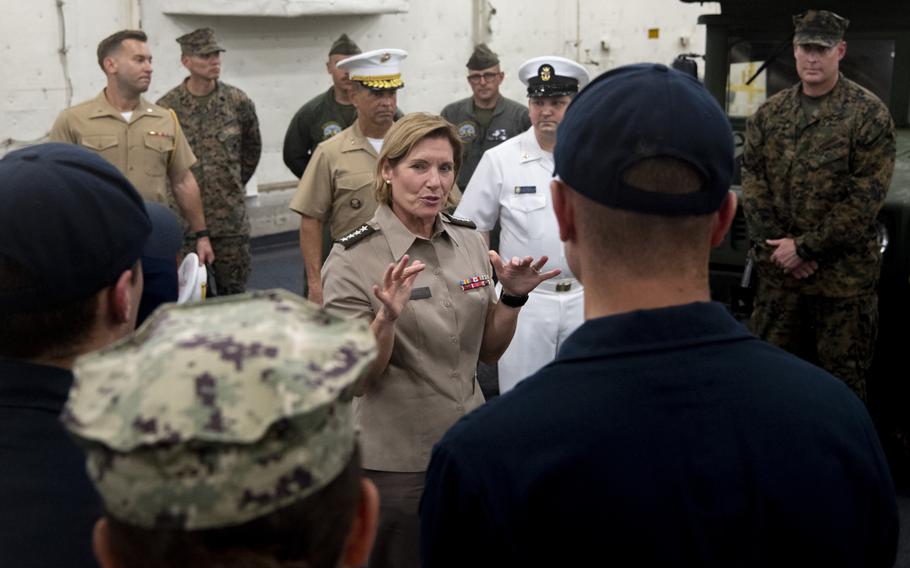
Army Gen. Laura Richardson, commander of Southern Command, speaks July 21, 2023, with sailors aboard the USS New York, a San Antonio-class amphibious transportation dock ship. (U.S. Navy)
WASHINGTON — China is expanding its influence into Latin America and the Caribbean, and it could present increasingly greater threats to the United States, the top U.S. military commander for the region said Friday.
“The importance of the region cannot be overstated,” said Army Gen. Laura Richardson, who leads U.S. Southern Command. “[China’s reach] is absolutely global and right under our nose and so close to our homeland.”
Last year, President Joe Biden’s National Security Strategy and the Pentagon’s National Defense Strategy identified China as the No. 1 global pacing challenge for the United States and repeatedly warned of rising Chinese influence — primarily in the Indo-Pacific region. But officials also warned China is becoming a greater threat in Latin America by spending large amounts of money in the region.
“They are on the 20-yard line to our homeland,” Richardson said, noting recent Chinese investments in the region on 5G cellular networks, deep-water ports and space-related infrastructure.
“What usually happens is [Latin American countries] are offered almost a zero-cost upgrade to the 5G, so it’s really hard for these leaders [to resist],” she said. “We need to be able to have alternative options for them to be able to select. And that’s where we’re being outcompeted by the Chinese right now.”
As many as 29 countries in Latin America have upgraded cellular networks with help from China, Richardson said.
U.S. concerns about China’s global expansion have escalated in 2023. In February, the U.S. military shot down what officials called a Chinese surveillance balloon after it floated across a large swath of the United States. The Pentagon later said the airship was one of many balloons that China has used in recent years to carry out surveillance activities around the world. Officials also said China had previously floated other balloons over the U.S. going back to former President Donald Trump’s administration. Just days after the balloon was shot down off the U.S. East Coast, another Chinese balloon was spotted over Colombia and Costa Rica. In both cases, China denied the objects were spy balloons.
Richardson, who in 2021 became the first woman to lead SOUTHCOM, said China’s Belt and Road Initiative — a large-scale project to engage economically with dozens of countries and organizations around the world on infrastructure and trade — has been a major reason why Beijing has been able to gain so much power in South and Central America. The National Bureau of Asian Research said a few years ago that the Chinese initiative had potential to partner them with more than 60 countries, influence more than 4 billion people and affect almost half of the global economy. Last year, the British-based Centre for Economics and Business Research said it expects the initiative to expand the global economy by $7.1 trillion annually by 2040.
According to the Council on Foreign Relations, a New York-based think tank, China already has surpassed the United States as South America’s largest trading partner.
“The United States and its allies fear that Beijing is using these relationships to pursue its geopolitical goals, including the further isolation of Taiwan, and to bolster authoritarian regimes such as those in Cuba and Venezuela,” the council said in June. “President Joe Biden, who sees China as a ‘strategic competitor’ in the region, has pledged greater economic cooperation with Latin America, but some analysts argue the United States should be doing more.”
Part of the reason so many Latin American and Caribbean countries are signing on to the Chinese project, Richardson said, is because they have no alternative. Often, she said, these countries cannot afford to turn down the billions of dollars offered by China. Some of the largest investments so far include an $8 billion nuclear power plant in Argentina, a $5.6 billion highway in Jamaica, a $5 billion energy refinery in Cuba and $6 billion worth of projects near the Panama Canal.
“When you are desperate for help, you’re going to turn to whoever is there. If someone throws you a rope, you don’t necessarily look at who’s giving you the rope. You just grab it,” Richardson said. “So, we need to have alternatives to [China].”
Other elements in Latin America and the Caribbean that are compounding the national security concerns, she said, are transnational criminal organizations that are heavily involved in drug and human trafficking.
“They stir the pot and make things very insecure; they scare the populations, and that allows China to come in,” she said. “These countries … are still digging out from [the coronavirus pandemic]. And when you talk about an 8% to 18% drop in gross domestic product, it’s huge. So, we have got to be there.”
Richardson’s predecessor, Adm. Craig Faller, voiced similar warnings when he was in charge of SOUTHCOM.
“We are losing our positional advantage in this hemisphere and immediate action is needed to reverse this trend,” he said two years ago. “We have seen many of these same tactics in Asia and Africa over the last few decades and we are well aware of the results. We must act now to avoid those same results in our own hemisphere.”
Richardson, 59, has been in command of SOUTHCOM since late 2021 and has held several other commands, including Army North, Army Forces Command and the Army Office of the Chief Legislative Liaison. She joined the Army in 1986 and became a Black Hawk helicopter pilot and was a military aide to Vice President Al Gore from 1999 to 2001. She was awarded several medals, including the Bronze Star and Legion of Merit.